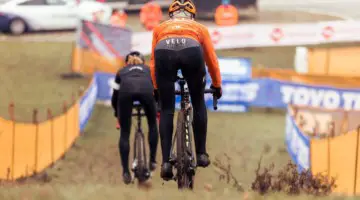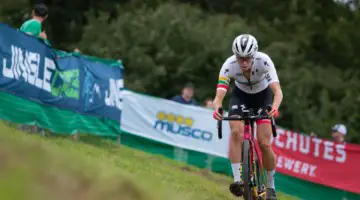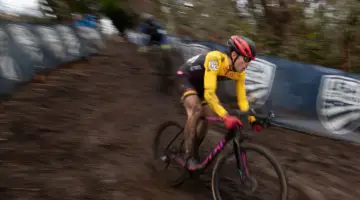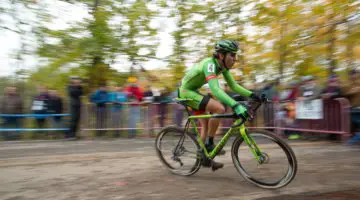This week’s Training Tuesday series article by Chris Mayhew of JBV Coaching focuses on how to prepare and plan to have the smartest start your cyclocross races this season. We put a lot of pressure on ourselves to have great starts, and Mayhew puts it into perspective and helps you prepare.

The start is a critical part of cyclocross racing. Do you know how to best approach it? photo: 2016 Worlds Junior Men’s start. © Danny Zelck / Cyclocross Magazine
The start. It’s a critical part of cyclocross and one that a lot of emphasis gets placed on. For a long time, it was the part of cyclocross I dreaded the most, given my stature and sprinting (in)ability. But I’m really in love with the idea that all the skills you need for ’cross are possible to master. You don’t need some outlandish talent or skillset, just a lot of work on the fundamentals. So I decided to face my fears and master my race starts. I’m not any faster at them, but I am a lot more comfortable with them—which pays dividends later in the race in terms of fewer mistakes and fewer matches burned. Let’s see what we can do to make your starts better in today’s Training Tuesday piece.
The first thing you can do to make your starts better is accomplished well before you arrive at the venue. Last week I discussed how to properly plan your race day routine, and that’s key to being stress-free and not missing your start. Know the rules of staging. Does this race stage by order of registration? Order of points you’ve accumulated in the series? UCI points? Crossresults ranking? Is it just a straight scrum? If it’s the first four methods then there’s nothing to do but keep an eye on the race website and see where you’ll be staged for race day. If it’s the latter option, show up to the line 20-30 minutes before your race. Also, see how you can volunteer your time next year to get your race(s) on a more civilized staging system. But know the rules of what you’re signing up for.
At this point we pick up about where last week’s column left off, with roughly 20 minutes before your race starts. Get to the start. If at all possible do two to four starts off the grid to the first corner. Is there a side of the starting grid that would make that first obstacle easier to get through? What’s the surface of the start? Gravel? Pavement? Grass? Are there giant potholes or a root you need to be aware of? Look at all the factors in the first few hundred meters of the race and see if there’s anything you can do to give yourself a bit of an edge.
At some point the officials will clear the starting area and herd you toward a staging area. Some races do a call up by row, that is 1-8, 8-16 and so on. Other events will call you up one by one by name. If you have any idea where you’ll be, place yourself in the staging pen appropriately, and don’t block the exit for other riders. Always walk to your starting spot. You can run faster than someone can clip in and pedal to the start. And if you have to jostle for a spot you’ll be more sure footed on, well, your feet.
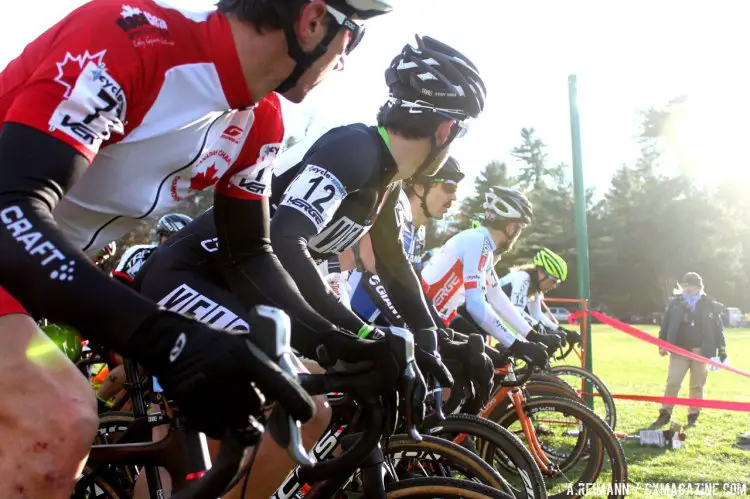
At the men’s start grid, some riders kept their eyes forward, while others battled the glaring sunlight to see the official preparing to blow her whistle. © Andrew Reimann
Now you probably have roughly five or so minutes to your start. Hopefully you’ve picked a side that gives you the best line through the first corner. Now look down and see what the starting surface is. If it’s pavement, that’s great, as it offers the most traction. You can start on the saddle just fine in this situation. If it’s grass, especially wet grass that early morning racers often face, think about how to best handle the limited traction that’s available. I’d suggest the top tube start listed on page two of Bill Schieken and Dan Tille’s Skill, Drills and Bellyaches book. Also, see also any Lars van der Haar start:
But make sure you practice that starting technique many, many times before you employ it in a race. If you’re starting on gravel or loose dirt, paw out a section of gravel using your foot and then place your rear tire in it, so you’re not doing a burnout on gravel at the start. Do the same thing if there’s snow or ice on a paved start. [Ed. note: See also Geoff Proctor’s discussion on start techniques and Sven Nys’ opinions on various styles.]
The last step is to make sure your cleats are clear. This is very important if it’s a muddy day or even if you walked through gravel during the day. Carry an Allen wrench in your pocket for cleaning out the cleat pocket of your shoe. In a pinch bang your shoe against your pedal a few times. Or find a stick at the start and use that. Last year I found a tent stake at the start and I wish I’d kept it for just such occasions. But don’t ruin a good start with a clogged up pedal.
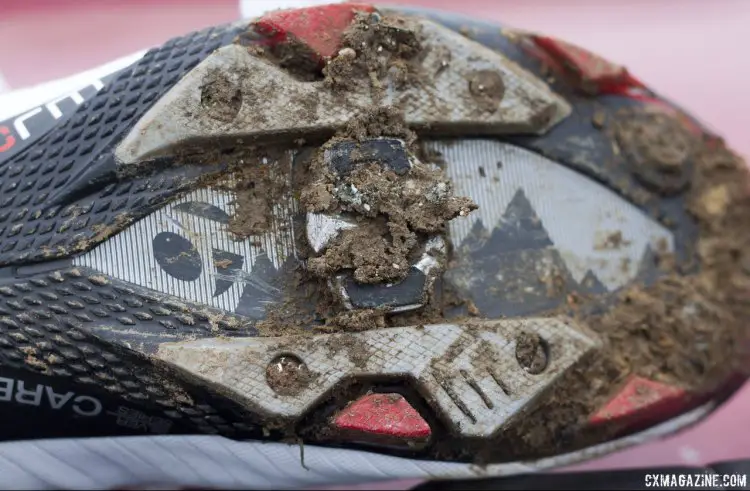
Is your cleat clear? Mayhew suggests bringing a small Allen wrench to the start to clear out your cleats for flawless clip-ins. © Cyclocross Magazine
Now the big question, how hard do I go? Before Crossresults told us how good or bad we were, that was a harder question to answer. If you’re not staged by Crossresults or don’t have enough races under your belt to seed the data, it’s still somewhat of a question. My general answer would be to go as hard as you need to so that you don’t handicap yourself, but no harder. There’s rarely an advantage to leading the first half lap. And you may be someone who is really good for short durations but not long ones. In that case it’s especially important that you not set fire to your whole matchbook in the first minute of the race, and instead save those matches for the latter parts of the race. There’s not a lot of advantage to starting very hard but there can be a lot of penalties.
If you are staged by Crossresults, or even series points, focus on just not losing spots. If you’re in the 3rd row, you’re expected to get around 20th place. Don’t lose any spots at the start, but don’t feel pressured to pass 10 people either. Again, do just enough to be where you should but remember you have 20-60 minutes to pass people. Maybe you’re better than your Crossresults prediction. That’s entirely possible. But the first minute of the race isn’t the place to prove that, a risky passing attempt can cost you a lot of energy, and potentially set you back further if you crash.
If you’re starting pretty far back, just do your best. It’s total chaos back there, and unpredictable. The good news is that because of the inevitable first-turn congestion, it’s nearly impossible to go too hard off the line, so you’re automatically starting somewhat conservatively. Do your best and accept that it’s chaos. Keep in mind that everyone makes mistakes or has bad luck, no matter where you start—it’s just the nature of racing. Just don’t let those mistakes get you down or convince you that you’re going to have a bad race. Yes, maybe you are having a bad start. Maybe you missed a pedal. Maybe you didn’t miss the person crashing in front of you. Don’t let any of that ruin your whole race.
Acknowledge your frustration with your situation, figure out how to fix the problem, and then put it behind you and focus on the rest of your race.
I missed my front row call up for a 100+ person race once. I started dead last, behind the last row. Focus on staying out of trouble for the start and then think about how you’re going to pass the person in front of you and don’t dwell on anything else.
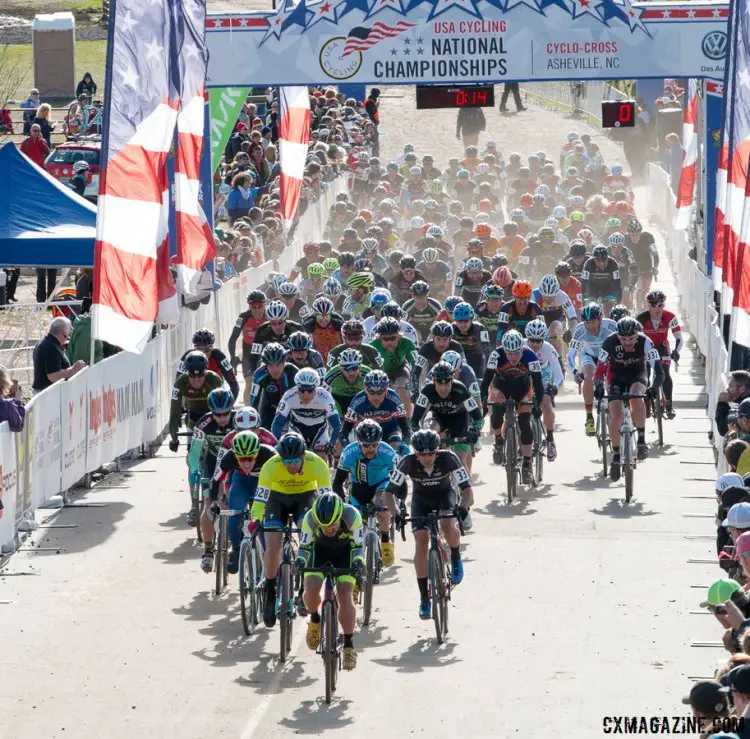
Miss your call-up, or don’t have the palmares to get a good call-up? There’s time to pass 151 racers, so don’t panic says Mayhew. photo: 2016 Singlespeed Cyclocross National Championships – 152 Starters. © Cyclocross Magazine
I will add that I did not cover the mechanics of starts. By that I mean how to position yourself on the bike, what gear to be in, where the pedals should be. That is a skill best covered in person, at either your local ’cross practice or perhaps a ’cross clinic. It’s definitely something we spend a lot of time on at the clinics I’ll lead this fall. Skills Drills and Bellyaches covers it pretty well, but it’s hard to learn to shoot a free throw from reading a book.
Starts are a big deal in ’cross. Honestly I think sometimes we make too big a deal out of them. That said, there are a lot of things you can do make your life easier at the start. Do some reconnaissance, make a plan and then execute it as best you can. Also, know that, as boxer Mike Tyson says, “Everyone has a plan till they get punched in the face” Starts are chaos. Do your best to execute your plan for the start but keep in mind you have plenty of race left at the start to deal with any setbacks. We’ll cover exactly that in the next column or two.
Cross Is Coming. Get ready for your best cyclocross season ever with more Training Tuesday pieces here from coaches Mayhew, Adam Myerson and Kenneth Lundgren and others.























